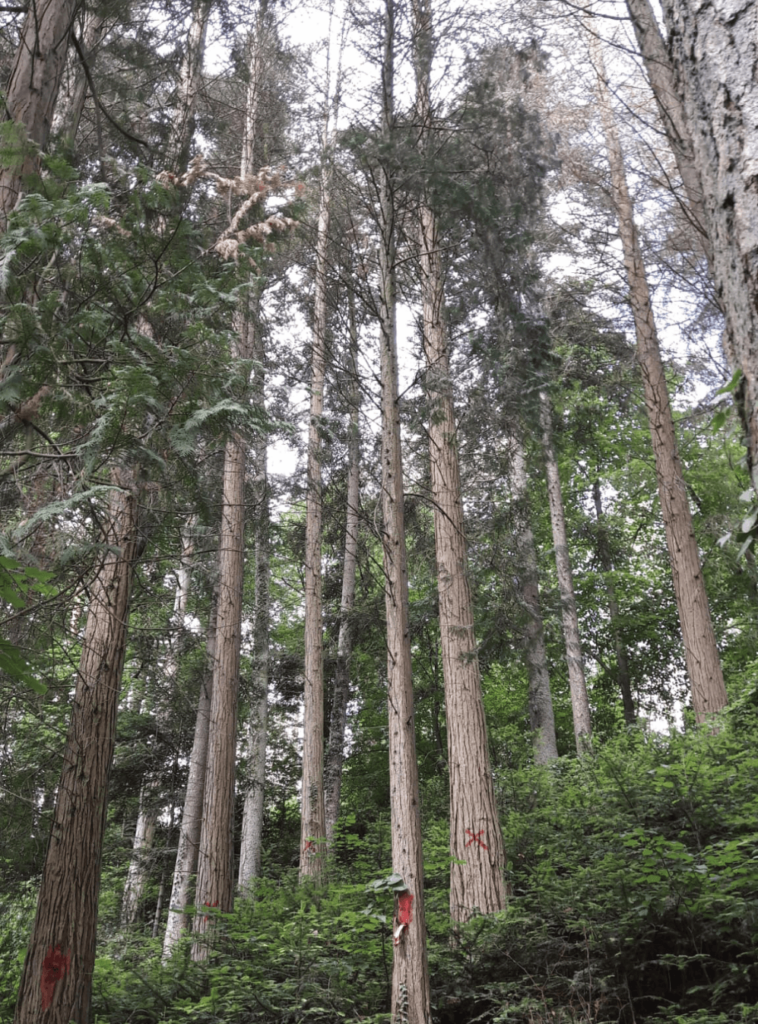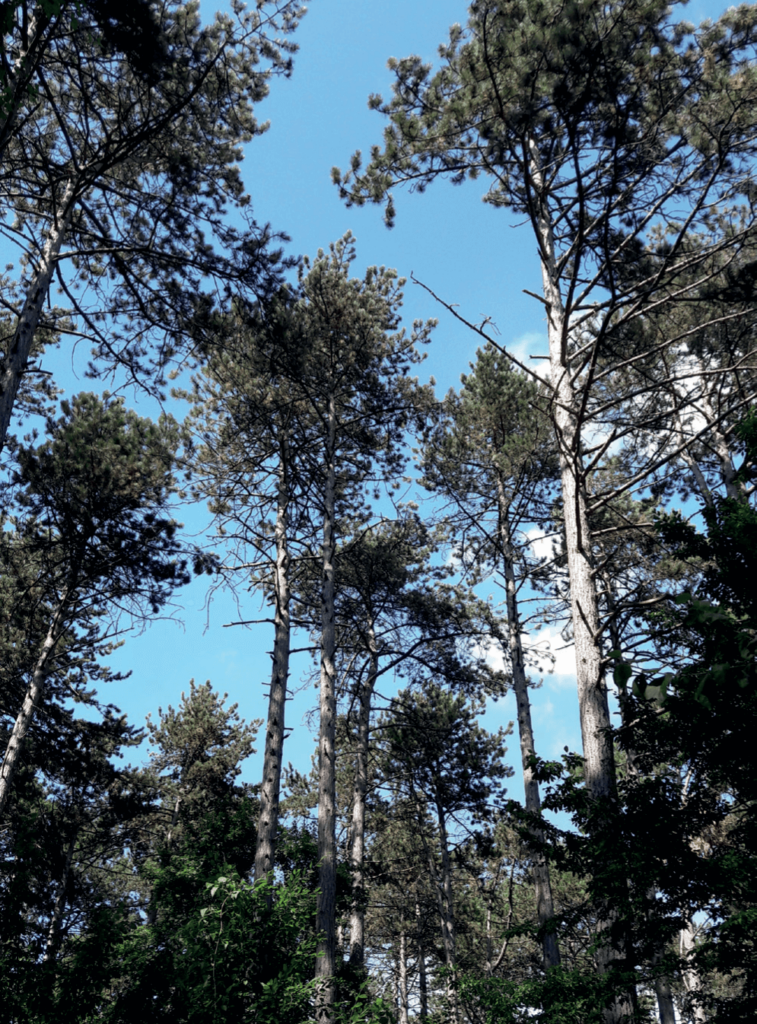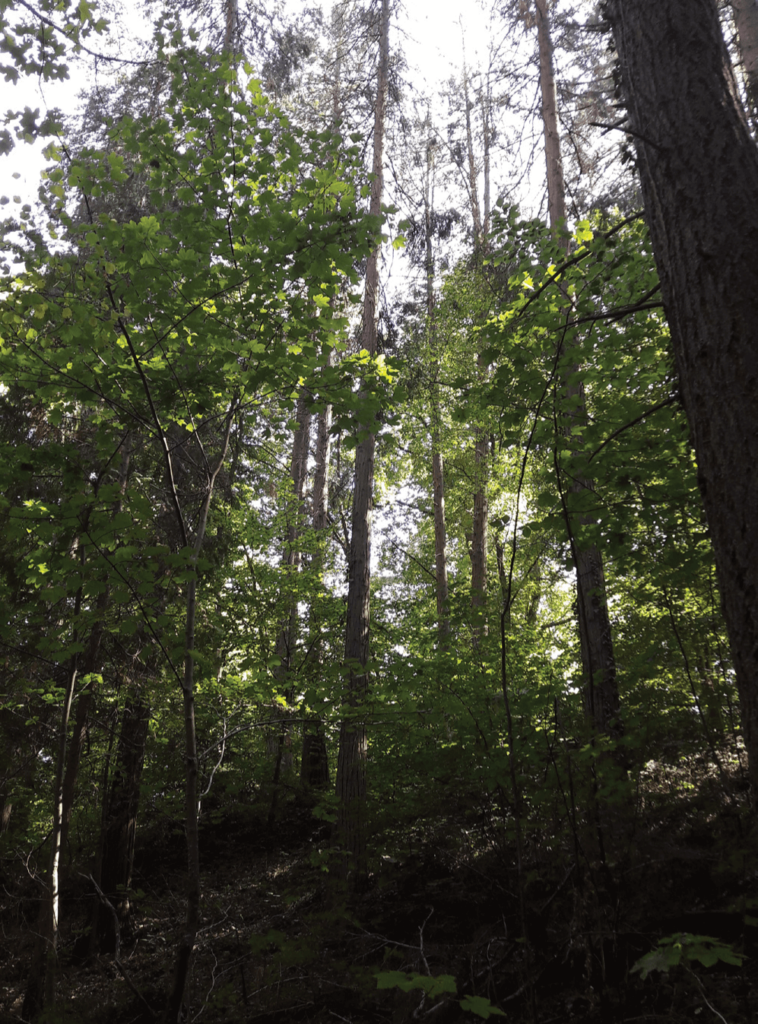Impact of climate change on production forests
Man and the forest
Impact of climate change
on production forests :
The example of the Mousty arboretum in Calestienne
by Pierre Lhoir (Volunteer at the Royal Forestry Society of Belgium) aith the participation of David Dancart (Société Royale Forestière de Belgique, coordinator of Silva Belgica)
For several decades now, scientists and climatologists have been predicting significant climate disruption. Rainfall patterns are no longer as regular as they used to be. They are rarer and more intense during the growing season. Mists and fogs are less and less frequent. All this has an impact on forest stands. Species that are sensitive to water deficits are the most affected, especially if they are planted on sites where the soil characteristics rapidly lead to water deficits in the event of high temperatures and/or a lack of rainfall.
Summary
The author of this article visited the Mousty arboretum in Calestienne this summer. Successive droughts have caused heavy mortality in many tree species. Few of them, such as Austrian black pine, Oriental spruce, Douglas fir and beech, are in a satisfactory state of health. What can we learn from these observations?
When I went to the Calestienne region this spring, I was struck by the sight of the stands of Norway spruce (Picea abies) drying out on the ground, along with a large proportion of the conifers in the Mousty arboretum in Nismes. Of course, the Calestienne region is made up of chalky, filtering soils that are prone to water shortages, but this is the first time we've seen damage on such a scale.
Genesis of the arboretum
When the Administration des Eaux et Forêts was created at the end of the 19e In the 19th century, its director Alexandre Dubois and the people in charge of the cantonments set up forest arboretums in the various bioclimatic zones of Belgium, with the aim of acclimatising a large number of mainly softwood species from the temperate regions of Europe, Asia and western North America. It was against this backdrop that Lucien Blondeau, a native of Nismes and the general warden at Couvin from 1895 to 1900, created a tienne1 overlooking his home town, the Mousty arboretum. When he died, a tribute was paid to him and a bronze commemorative plaque was set into a Frasnian limestone wall.2.
It is still visible and could be included in our forestry heritage.
A region of contrasts
Within a 15-kilometre radius of the Mousty arboretum, you will pass through three natural regions of the Mosan district. The first, situated furthest north, is the Fagne-Famenne depression, a humid region covered with forests, meadows and hedged farmland. To the south, with the first foothills of the Ardennes, we find the second: Thiérache. Finally, the third, wedged between the other two, the Calestienne. Here we can see a succession of small limestone hills (tiennes) on which a wide variety of vegetation grows: dry grasslands, coppice under high forest, high forest, meadows and hedged farmland.
The climax forest (natural forest in equilibrium with the environmental conditions in the absence of human intervention) of the Calestienne is the Carici-Fagetum beech forest on limestone. This was heavily exploited in the nineteenth century to make way for lawns on which flocks of sheep and goats grazed intensively. These grasslands were probably never mown and were burnt each year in the spring. The deepest soils were cultivated. This method of agropastoral cultivation lasted for a very long time, before gradually disappearing at the beginning of the twentieth century. All these limestone hills, which were still just bald mountains at the beginning of the century, have now been almost entirely re-colonised by forest, either naturally (deciduous) or artificially (coniferous), mainly by Austrian black pine.
Description of the arboretum
Location : Walloon Region, Province of Namur, Commune of Viroinval, Place : Mousty
- Bioclimatic region: Fagne, Famenne and Calestienne.
- Altitude: 170-210 m
- - Exhibition: east
- Slope: from 5 % to over 15 %
- Average annual precipitation: 976 mm (2018)
- Soils: Gbbk4 and Gbbk6: stony loam soils with a limestone or limestone-containing load and almost exclusively favourable natural drainage, rather shallow (20 to 40 cm) and kEbb3: clay soil with favourable to imperfect natural drainage on a limestone substrate.
Note
To find out more about the symbols that characterise Belgian soils, see points 7 to 12 of the help section of the Ecological Species File (https://www.fichierecologique.be/).
Inventory of the arboretum
Growing on extremely stony and sloping soil, making the site xeric, some of the species introduced to the arboretum have disappeared over time. The gaps have largely been colonised by beech (Fagus sylvatica). All stages of development are present, from seedlings to old, low-branched specimens.
Other species have been able to grow satisfactorily. There are Douglas firs (Pseudotsuga menziesii) and several very large fir species. During an inventory carried out in 2017, most of the species still present showed no signs of decline. Climate change is leading to increasingly frequent periods of drought. The spring of 2022 was no exception to this trend. On my visit to Nismes in late spring, I was able to see the extent of the damage. Entire cells are
dead and dried out. This affects almost all stands. This is a perfect illustration of the limitations of certain species planted in a xeric environment.3.
Some of the trees in the arboretum are dead on their feet, while others are showing signs of decay. These include the Pectin fir (Abies alba), native to the humid mountainous regions of Europe, the Giant or Vancouver fir (Abies grandis), which grows in the maritime regions of the American West, and the Colorado fir (Abies concolor), which comes from the rocky mountains of Idaho in Wyoming. The same applies to Norway spruce (Picea abies). Patches of western red cedar (Thuya plicata) and Lawson cypress (Chamaecyparis lawsoniana) have been completely eradicated. Douglas firs, on the other hand, seem to be holding up well.
Douglas fir and origins
The natural distribution of Douglas fir extends from northern California to northern British Columbia, and from the coastal zone to the Cascade Mountains. This species is therefore found naturally in a wide range of latitudes. The Douglas firs planted here are mainly of North American origin (Washington State). In order to further study the potential of this species, particularly in the face of drought, trials with southern provenances should be the subject of increased interest. This is what the Royal Forestry Society is doing by testing a Californian provenance as part of the Trees For Future. Unfortunately, the origin of the Mousty arboretum is not known.
This visit was a good opportunity to take a closer look at the development of the Oriental spruce (Picea orientalis), a species from the Western Caucasus. This species is being tested by the Société Royale Forestière de Belgique (SRFB) as part of its Trees for Future the aim of which is to identify the tree species and origins that will help forests adapt to climate change. In the cell containing the eight specimens in the arboretum, only the central tree has withered, while the others are still very green. It should be noted that the lack of thinning means that the crowns are narrow and underdeveloped, which can have a negative impact on the trees' vigour.
After this (non-exhaustive) inventory of the arboretum, we thought it would be interesting to leave the arboretum and analyse the state of health of the various stands in the surrounding area.
Note
There are still two examples of Serbian spruce (Picea omorika) in the arboretum. This species, which is small and very fragmented, is native to the Balkans. The two specimens in the arboretum have a very narrow crown covering more than a third of the tree's height. The colour of the needles is a bright light green, which contrasts well in this very shady environment. Although this tree has no silvicultural value, it does have great aesthetic and ornamental appeal. It would look great at the entrance to a property or in a small cluster on a lawn.
Stand of Austrian black pine
A large part of the plateau is covered by an old stand of Austrian black pine (Pinus nigra ssp nigricans). The crowns are naturally narrow and some trees have died back.
Overall, the stand is still in place and in a satisfactory state of health. (see photo 2).



Remarks
What's interesting about sun-loving species like Austrian black pine is that the lower strata can be rich and lush. This is the case here. Many limestone-dependent species are present in both the shrub and herb layers. It would be interesting to carry out an inventory. There is a good chance of encountering calcicolous species such as the bird's nest orchid (Neottia nidus-avis) or the male orchid (Orchis mâle), as well as numerous herbaceous species such as brachypodes, glaucous sedges (Carex flacca), fetid hellebore (Helleborus foetidus), etc.
The Austrian black pine occurs naturally in the south of Vienna, at altitudes of between 250 m and 750 m, in the deciduous oak zone: hairy oak and pubescent oak (Quercus cerris and Quercus pubescens). The latter was indigenous to the Calestienne region. It was found mixed in xeric oak forests with sessile oak (Quecus petraea). These were overexploited in the nineteenth and twentieth centuries. Pubescent oak has completely disappeared from Calestienne as a result of the over-exploitation of coppices and it is a shame that it has not been tested in this arboretum. On the other hand, this species is part of the panel of species tested in the Trees for Future project, with French and Italian provenances.
It should be noted that all the plots of common spruce in the vicinity of the arboretum have dried out.
Beech forest on limestone
Further along the plateau, following on from the stand of Austrian black pines, we came across a beautiful beech forest that had been planted as part of a trial of provenances. On closer inspection, it showed no signs of dying back.
Conclusion
Many species, both in the arboretum and in the surrounding area, have been affected by the successive droughts we are experiencing, some of them spectacularly so. Of course, the species concerned and mentioned above are sensitive, even very sensitive, to water deficit and the Calestienne is a region of Wallonia where the lack of water is quickly felt. However, these species and stands have so far proved resilient. These observations confirm the need, already rightly mentioned many times in Silva BelgicaIt is also important to be even more attentive to this point in terms of sensitivity to water deficit, heatwave and drought. These precautionary measures must be taken throughout Wallonia because, for example, the acid brown soils of the Ardennes located on a steep slope with hot exposure are likely to pose similar problems to those encountered in Calestienne. As well as taking these parameters into account, it is important to change the way we farm and plant by diversifying species, mixing them and integrating them into existing planting beds. Remember that heterogeneity is a resilience factor. Monocultures are therefore more exposed to climatic and other stresses.
Some of our readers may also have been surprised by the report on observations of beech trees presented in the previous lines. Beech is very sensitive to heatwaves, summer droughts and lack of water in general. It is a species at risk in the context of climate change. This species is excluded on xeric soils and in extended tolerance (only as a companion species) on dry soils (for more information, consult the dedicated species sheet on https://www.fichierecologique.be/).
However, beech is the dominant species in the Carici Fagetum (calcicole beech forest or sedge beech forest). It may or may not be accompanied by other species such as sessile oak (pubescent oak), sycamore maple, ash, or even lime and hazel. The undergrowth is open with numerous shrubs and a well-developed herbaceous layer. This dry forest habitat is found on superficial, stony, brown limestone soils, mainly in the Calestienne region and on the limestone slopes of the Mosan valleys.
We will not venture into complex explanations here. However, we can assume that Calestienne beech trees have, over the generations, developed particular adaptations to strong hydric constraints on these chronically xeric soils and are therefore less affected in the event of drought than stands that have developed in less restrictive conditions.
In addition to self-ecology4 of species, an essential parameter in the process of choosing species for reforestation, the forester must also take into account natural dynamics and local adaptation, which, with all their species assemblages, guarantee more functional ecosystems that are more resistant and resilient to climatic and health hazards.
As Evrard de Turckheim points out in the article on page 8 of Silva Belgica n°5|2022, we must not be too hasty in condemning our native species, and we must show restraint and observation when it comes to introducing new species. Assisted migration, as tested in Trees for Future and in the arboretums, should not be seen as competing with natural adaptation, but as a complement to it where it proves insufficient.
What SRFB thinks
This article is interesting for several reasons. It highlights the major dieback phenomena that we can all observe in our woods, on different species and in different site conditions, as a result of increasingly recurrent summer droughts. It also shows that adapting forests to the future climate cannot be based on a single, simple recipe.
Thus, on the site of the Mousty arboretum and in its immediate environment, two paths of adaptation, which are sometimes presented as contradictory, coexist: the introduction of exotic species better adapted to the new/future climate on the one hand, and the natural capacity of local populations to adapt to the new conditions on the other.
Among the species planted in the arboretum, several are showing an inability to withstand extreme conditions such as the drought of 2022. European mountain fir and Western American fir, for example, have shown their limitations. On the other hand, the Oriental spruce, for example, seems to be rather better equipped than its cousin, the common spruce. This is a fine demonstration, if one were needed, of the value of the historical arboretums and the more recent ones set up as part of Trees for Future. In addition, the beech, which elsewhere is highly susceptible to drought, is doing wonderfully well here despite the harshness of the environment, demonstrating the great genetic diversity of native species and highlighting the need to investigate this diversity and invest once again in forest genetics.
The new species, those that stand out in the arboretums, do not replace the species already present but complement them. The challenge of adapting forests to climate change is colossal, and it is only by combining all the solutions and favouring one or other depending on the context that we can hope to maintain a healthy and (multi) functional forest cover.
- Small limestone hill.
- The Frasnian is the first geological stage of the Upper Devonian in the Palaeozoic era. Source: Wikipedia.
- Refers to an environment characterised by a very poor water balance, leading to marked drought. Source: Forestry vocabulary - Ecology, management and conservation of wooded areas. Christian Gauberville, Yves Bastien - CNPF-IDF - 2011
- Auto-ecology: the study of how the environment affects the morphology, physiology and behaviour of a species. Autoecology essentially defines the tolerance limits and preferences of species considered in isolation with regard to various ecological factors. Forestry vocabulary - Ecology, management and conservation of woodland areas. Christian Gauberville, Yves Bastien - CNPF-IDF - 2011
Bibliography
- AL. Jacquemart, P. Lhoir. Initiation to the recognition of forest formations in Wallonia. (2017)
- S. Vanwijnsberghe. Trees of memory in the Forêt de Soignes (Forêt.Nature n°163- 2022)
- C. Vandermotten, C. Neuray, Y. Quinif, JJ van Mol. Route of the Calestienne. (SRGB 2006)
- EF Debazac. Manual of conifers. (GB 1964)
- E. Scholzen, P. Lhoir, Inventaire et proposition de valorisation des arboretums publics de Région wallonne (Earth and Life Institute, UCLouvain 2018)
- https://www.fichierecologique.be
- http://biodiversite.wallonie.be
